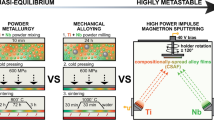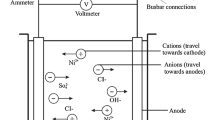Abstract
Mo-Si-Ti coating was prepared on the surface of γ-TiAl by means of the double-glow plasma surface alloying technique at different soaking times. The coating had good surface quality and was primarily composed of (Ti, Mo)5Si3, TiSi2, TiSi, Ti5Si3, Ti5Si4, and MoSi2. It was observed that the thickness of the deposition layer increased with increasing holding time. However, the thickness of the diffusion layer did not increase further when the holding time exceeded 2 h. The hardness and elastic modulus of the Mo-Si-Ti coating first increased and then decreased with the increase in soaking time. Low crystallite size and a hard phase in the Mo-Si-Ti coating prepared at a soaking time of 2 h were responsible for its high hardness of 26.3 GPa. The results of the nanoindentation test with loading rates of 100-5000 μN/s and a holding time of 10 s showed that the loading rate did not affect the elastic modulus of γ-TiAl and Mo-Si-Ti coating. On top of that, γ-TiAl exhibited strain-hardening behavior with an increase in loading rate, and the Mo-Si-Ti coating exhibited strain-hardening behavior at low loading rates and strain-softening behavior at high loading rates. The results of the nanoindentation test with loading rates of 100-5000 μN/s and holding times of 2-10 s showed that the hardness of γ-TiAl and the Mo-Si-Ti coating varied with those parameters because of the difference in the plastic energy accumulation and release time. When the loading time was short, γ-TiAl exhibited strain-hardening behavior at low loading rates and strain-softening behavior at high loading rates. However, the Mo-Si-Ti coating exhibited strain-hardening behavior at all loading rates. The strain-hardening behavior of γ-TiAl was observed at all loading rates when the retention time was long. However, the Mo-Si-Ti coating exhibited strain-hardening behavior at low loading rates and strain-softening behavior at high loading rates.



















Similar content being viewed by others
References
H. Lin, W. Liang, Y. Jia, Q. Miao, Hu. Rongyao, Z. Ding and Yu. Lijia, Effect of Al-Y Gradient Coating on Hot Corrosion Resistance of γ-TiAl Alloy at Different Temperatures, Appl. Surf. Sci., 2019, 487(1), p 868–875.
V. Singh, C. Mondal, A. Kumar, P.P. Bhattacharjee and P. Ghosal, High Temperature Compressive Flow Behavior and Associated Microstructural Development in a β-Stabilized High Nb-Containing γ-TiAl Based Alloy, J. Alloys Compd., 2019, 788, p 573–585.
B.H. Clemens and H. Kestler, Processing and Applications of Intermetallic γ-TiAl-Based Alloys, Adv. Eng. Mater., 2000, 9, p 551–570.
E.A. Loria, Gamma Titanium Aluminides as Prospective Structural Materials, Intermetallics., 2000, 8, p 1339–1345.
K. Zhang, L. Xin, L. Yiliang, Y. Cheng, X. Wang, S. Zhu and F. Wang, Improving Oxidation Resistance of γ-TiAl Based Alloy by Depositing TiAlSiN Coating: Effects of Silicon, Corros. Sci., 2021, 179, p 109151.
C.L. Chu and S.K. Wu, A Study on the dry Uni-Directional Sliding Behaviour of Titanium Aluminides, Scr. Metall. Mater., 1995, 33(1), p 139–143.
J. Qiu, F. Zhengfan, B. Liu, Y. Liu, J. Yan, D. Pan, W. Zhang and I. Baker, Effects of Niobium Particles on the Wear Behavior of Powder Metallurgical γ-TiAl Alloy in Different Environments, Wear, 2019, 434, p 202964.
Y. Liao, B. Zhang, M. Chen, M. Feng, J. Wang, S. Zhu and F. Wang, Self-Healing Metal-Enamel Composite Coating and Its Protection for TiAl Alloy Against Oxidation under Thermal Shock in NaCl Solution, Corros. Sci., 2020, 167, p 108526.
J. Małecka, Effect of an Al2O3 Coating on the Oxidation Process of a γ-TiAl Phase Based Alloy, Corros. Sci., 2012, 63, p 287–292.
P. Raluca, S. Friedle and M. Schütze, Oxidation Protection of γ -TiAl-Based Alloys—A Review, Intermetallics, 2015, 56, p 1–14.
A. Rahmel, M. Schütze and W.J. Quadakkers, Fundamentals of TiAl Oxidation—A Critical Review, Mater. Corros., 1995, 46(5), p 271–285.
S. Krol and M. Prazmowski, High-Temperature Oxidation of Gamma-TiAl Based Alloys: Generation of Oxidized Layer, Mater. Eng., 2006, 3, p 456–459.
D. Schliephake, A. Kauffmann, X. Cong, C. Gombola, M.A. Azim, B. Gorr, H.-J. Christ and M. Heilmaier, Constitution, Oxidation and Creep of Eutectic and Eutectoid Mo-Si-Ti Alloys, Intermetallics, 2019, 104, p 133–142.
S. Majumdar, B. Paul, P.K. Singh, J. Kishor and V. Kain, Effect of Sicontent on Microstructure, Mechanical and Oxidationproperties of Hot Pressed Mo-Ti-Si Alloys, Intermetallics, 2018, 100, p 126–135.
L. Qiong, Y. Hao, Y. Wang, P. Feng and J. Fan, Microstructural Evolution and High-Temperature Oxidation Mechanisms of a Ti-Mo-Si Composite, Corros. Sci., 2019, 161, p 108180.
T.A. Parthasarathy, M.G. Mendiratta and D.M. Dimiduk, Oxidation Mechanisms in Mo-Reinforced Mo5SiB2(T2)–Mo3Si Alloys, Acta Materialia, 2002, 50(7), p 1857–1868.
S. Obert, A. Kauffmann, S. Seils, T. Boll, S. Kauffmann-Weiss, H. Chen, R. Anton and Martin Heilmaier, Microstructural and Chemical Constitution of the Oxide Scale Formed on a Pesting-Resistant Mo-Si-Ti Alloy, Corros. Sci., 2021, 178, p 109081.
S. Obert, A. Kauffmann, S. Seils, S. Schellert, M. Weber, B. Gorr, H.-J. Christ and M. Heilmaier, On the Chemical and Microstructural Requirements for the Pesting-Resistance of Mo-Si-Ti Alloys, J. Market. Res., 2020, 9, p 8556–8567.
S. Obert, A. Kauffmann and M. Heilmaier, Characterisation of the Oxidation and Creep Behaviour of Novel Mo-Si-Ti Alloys, Acta Mater., 2020, 184, p 132–142.
A.M. Chaze and C. Coddet, Influence of Silicon on the Oxidation of Titanium Between 550 and 700 °C, Oxid. Met., 1987, 27(1), p 1–20.
S. Yuan, N. Lin, Q. Zeng, H. Zhang, X. Liu, Z. Wang and Wu. Yucheng, Recent Developments in Research of Double Glow Plasma Surface Alloying technology: A Brief Review, J. Market. Res., 2020, 9(3), p 6859–6882.
X.X. Luo, Z.J. Yao, P.Z. Zhang, Q. Miao, W.P. Liang, D.B. Wei and Y. Chen, A Study on High Temperature Oxidation Behavior of Double Glow Plasma Surface Metallurgy Fe-Al-Cr Alloyed Layer on Q235 Steel, Appl. Surf. Sci., 2014, 305, p 259–266.
D.B. Wei, P.Z. Zhang, Z.J. Yao, X.F. Wei, J.T. Zhou and X.H. Chen, Preparation and High-Temperature Oxidation Behavior of Plasma Cr-Ni Alloying on Ti6Al4V Alloy Based on Double Glow Plasma Surface Metallurgy Technology, Appl. Surf. Sci., 2016, 388, p 571–578.
Z. Xu and F.F. Xiong, Plasma Surface Metallurgy, Springer, Singapore, 2017. https://doi.org/10.1007/978-981-10-5724-3
M. Ciavarella and G. Demelio, A Review of Analytical Aspects of Fretting Fatigue, with Extension to Damage Parameters, and Application to Dovetail Joints, Int. J. Solids Struct., 2001, 38, p 1791–1811.
Y. Yang, C. Wang, Y. Gesang, H. Shang, R. Wang, Y. Liang, T. Wang, Q. Chen and T. Shao, Fretting Wear Evolution of γ-TiAl Alloy, Tribol. Int., 2021, 154, p 106721.
E. Lemoine, D. Nelias, F. Thouverez and C. Vincent, Influence of Fretting Wear on Bladed Disks Dynamic Analysis, Tribology International, 2020, 145, p 106148.
M. Nasim, Y. Li and C. Wen, Individual Layer Thickness-Dependent Nanoindentation and Nanotribological Behaviors of Ta/Co Nanolaminates, Tribol. Int., 2021, 156, p 106845.
M. Gadge and S. Chinchanikar, Characterization of Pre-and/or Post-treated PVD-AlTiN Coating: Nanohardness, Modulus of Indentation and Percent Elastic Portion of the Nanoindentation, Materialstoday Proc., 2021 https://doi.org/10.1016/j.matpr.2021.03.439
D. Peykov, E. Martin, R.R. Chromik, R. Gauvin and M. Trudeau, Evaluation of Strain Rate Sensitivity by Constant Load Nanoindentation, J. Mater. Sci., 2012, 47, p 7189–7200.
G.K. Williamson and W.H. Hall, X-ray Line Broadening from Filed Aluminium and Wolfram, Acta Metall., 1953, 1, p 2231. https://doi.org/10.1016/0001-6160(53)90006-6
G. Dini, R. Ueji, A. Najafizadeh and S.M. Monir-Vaghefi, Flow Stress Analysis of TWIP Steel Via the XRD Measurement of Dislocation Density, Mater. Sci. Eng. A., 2010, 527, p 2759–2763.
K.H. Westmacott and R.E. Smallman, Stacking Faults in Face-Centred Cubic Metals and Alloys, Philos. Mag., 1957, 2, p 669–683.
D.B. Miracle, Overview No. 104 the Physical and Mechanical Properties of NiAl, Acta Metall. Mater., 1993, 41(3), p 649–684.
R. Noebe, R. Bowman and M. Nathal, Physical and Mechanical Properties of the B2 Compound NiAl, Int. Mater. Rev., 1993, 38(4), p 193–232.
D.J. Li, M. Tan, G.Q. Liu, M.Y. Liu, X.Y. Deng, H. Liu and X. Sun, The Influence of N+ Beam Bombardment and Deposition Temperature on the Growth of ZrB2/WNx Nanomultilayers, Surf. Coat. Technol., 2010, 205(1), p S5–S10.
Anil Kumar, S.K. Nayak, A. Pathak, A. Banerjee and T. Lah, Investigation of Nanomechanical Deformation Behavior in Plasma Sprayed Fe-Based Amorphous/Nanocrystalline Composite Coating via Multi-scale Indentation and Nanotribology, Journal of Non-Crystalline Solids., 2020, 545, p 120244.
Y.S. Mohammed, D.S. Stone and A.A. Elmustafa, Strain rate sensitivity of hardness in indentation creep with conical and spherical indenters taking into consideration elastic deformations, Int. J. Solids Struct., 2021, 212, p 143–151.
N. Kikuchi, M. Kitagawa, A. Sato, E. Kusano, H. Nanto and A. Kinbara, Elastic and Plastic Energies in Sputtered Multilayered Ti-TiN Films Estimated by Nanoindentation, Surf. Coat. Technol., 2000, 126(2), p 131–135.
Y.W. Bao, W. Wang and Y.C. Zhou, Investigation of the Relationship Between Elastic Modulus and Hardness Based on Depth-Sensing Indentation Measurements, Acta Mater., 2004, 52(18), p 5397–5404.
X.W. Nie and Q. Lu, Fracture Toughness of ZrO2-SiC/MoSi2 Composite Ceramics Prepared by Powder Metallurgy, Ceram. Int., 2021. https://doi.org/10.1016/j.ceramint.2021.03.309
J.J. Petrovic, Mechanical Behavior of MoSi2 and MoSi2 Composites, Mater. Sci. Eng. A, 1995, 192, p 31–37.
H. Hu, Y. Guo, J. Yan, J. Qiu, Y. Wang, Dry Sliding Wear Behavior of MoSi2-Mo5Si3-Mo5SiB2 Composite at Different Temperatures and Loads, Wear, 2019, 428, p. 237–245.
J.L. Wang, D.J. Ma and L. Sun, The Influence of Crack Forms on Indentation Hardness Test Results for Ceramic Materials, J. Mater. Sci., 2015, 50(18), p 6096–6102.
Acknowledgment
This project was supported by Natural Science Foundation for Excellent Young Scientists of Jiangsu Province, China (Grant No. BK20180068), China Postdoctoral Science Foundation funded project (Grant No. 2018M630555), Opening Project of Materials Preparation and Protection for Harsh Environment Key Laboratory of Ministry of Industry and Information Technology (Grant No. XCA20013-1), the Natural Science Foundation of Ningbo Province, China (Grant No.202003N4341),China Postdoctoral Science Foundation, (Grant No.2020M681460), Major special project of "scientific and technological innovation 2025" in Ningbo, (Grant No.2019B10086).
Author information
Authors and Affiliations
Corresponding author
Additional information
Publisher's Note
Springer Nature remains neutral with regard to jurisdictional claims in published maps and institutional affiliations.
Rights and permissions
About this article
Cite this article
Li, F., Zhang, P., Wei, D. et al. The Influence of Loading Rate and Hold Time on the Nano-mechanical Properties of γ-TiAl and Plasma Mo-Si-Ti Coating. J. of Materi Eng and Perform 31, 7368–7381 (2022). https://doi.org/10.1007/s11665-022-06754-z
Received:
Revised:
Accepted:
Published:
Issue Date:
DOI: https://doi.org/10.1007/s11665-022-06754-z




